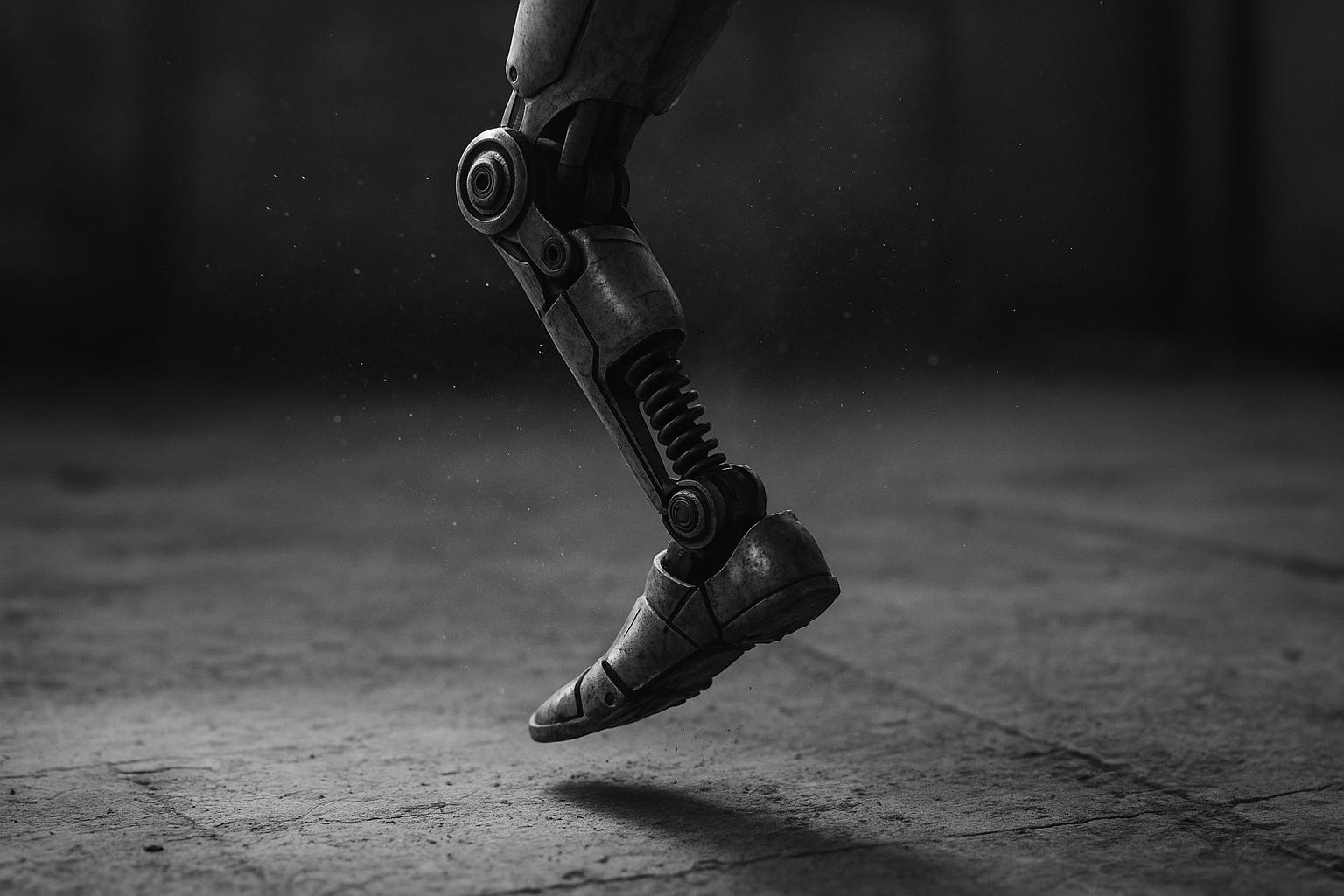Industry insiders say recent demo theatrics mask a deeper problem: brain‑first, rigid designs waste energy and struggle in unstructured settings. New funding and prototypes from Sony, London South Bank University and Boston Dynamics point to a shift toward compliant, body‑centric engineering that could make humanoids practical beyond staged videos.
Watch a clip of a humanoid robot executing balletic flips and it is tempting to conclude the robotics revolution has arrived. Yet industry insiders and academics increasingly say the revolution is partial: far more progress has been made on brains — vision systems, planning and large neural networks — than on the bodies that must carry those brains into the messy real world. According to Hamed Rajabi, director of the Mechanical Intelligence Research Group at London South Bank University, Sony’s recent call for research into “flexible structural mechanisms” underlines that concern and signals a new emphasis on physical design as much as software. Boston Dynamics’ recent unveiling of an all‑electric Atlas, meanwhile, shows firms are experimenting with hardware redesigns even as their demo reels continue to capture the public imagination. (Sources: lead analysis of the problem; Sony research themes; Boston Dynamics unveiling.)
The core technical problem is simple to state but hard to solve: most humanoid robots are built with a brain‑first architecture and rigid joints, which forces powerful actuators and continual computational corrections to keep the machine upright and effective. That approach is energetically expensive. As one industry comparison put it, Tesla’s Optimus consumes roughly 500 watts per second to walk where a human uses around 310 watts per second — a near‑50 per cent energy penalty to perform a simpler, less capable gait. The consequence is that today’s humanoids often operate as research platforms rather than practical, long‑duration field machines. (Source: detailed critique of brain‑first designs and energy figures.)
That gap between showmanship and robustness is visible in high‑profile demos. Tesla’s video of Optimus folding a T‑shirt drew scrutiny: independent coverage argued the clip was staged and highlighted that the firm’s founder later acknowledged the robot “cannot yet do this autonomously,” suggesting teleoperation or pre‑scripted motion played a role. Such demonstrations can therefore reveal more about limb kinematics and choreography than about tactile adaptability or resilience in unstructured environments. The caution is not a dismissal of progress but a reminder that impressive motions do not yet equal dependable, unsupervised service work. (Source: reporting on Tesla’s demo and subsequent clarifications; contextual analysis.)
At the same time, hardware‑led efforts are advancing. Boston Dynamics’ next‑generation Atlas — an all‑electric redesign revealed in April — introduces new joint architectures and quieter operation and the company has described plans to test the platform with industrial partners. But even machines that look impressively fluid in controlled videos struggle with real‑world unpredictability: feet that cannot sense or conform to irregular terrain, or bodies that cannot yield and spring back when interacting with complex, organic environments. Those limits help explain why much of the current fleet remains best suited to labs and controlled industrial settings. (Source: Boston Dynamics unveiling and limitations discussed.)
The field of mechanical intelligence — sometimes shortened to MI — offers a different starting point: rather than asking a central computer to micromanage every motion, MI asks whether the body itself can perform part of the computation through morphology. Rajabi and colleagues point to everyday biological examples: pine cones that open and close in response to humidity with no nervous system input, tendons that store and release energy to stabilise gaits, and soft human skin and tissue that passively conform to objects to make grasping efficient. Making bodies that are compliant, spring‑like and adaptive could allow a robot’s software to focus on higher‑level strategy rather than continuous low‑level corrections. (Sources: explication of MI and biological examples; MI research framing.)
That research is already being translated into concrete engineering work. London South Bank University’s Mechanical Intelligence group lists projects such as hybrid hinges that mix rigid precision with compliant, shock‑absorbing behaviour, tensegrity and adaptive grippers intended to reduce reliance on active sensing and control. Sony’s Research Award programme has also begun to channel grants into related lines of inquiry — offering modest funding to academic teams to explore flexible structural approaches, physics‑based simulation and novel actuators — signalling that major corporate players are willing to underwrite body‑level innovation alongside AI. (Sources: MI group projects; Sony research award programme.)
But the biological analogies carry important caveats. Experimental biology reminds engineers that tendon elasticity and springy elements do not automatically translate into lower metabolic cost or simpler control: laboratory studies have shown that replacing active muscle work with tendon‑like behaviour does not always produce a measurable reduction in the energetic cost of producing force, and that benefits depend on the whole muscle–tendon architecture and how it is integrated into movement. In short, copying a single biological feature is unlikely to yield a turnkey improvement; success depends on system‑level design and careful translation from biology to engineering. (Source: experimental biology research on tendon elastic storage and its limits.)
There are also industrial and economic hurdles. The companies currently at the forefront of humanoid robotics tend to be software and electronics firms with supply chains optimised for motors, sensors and compute; building bodies that exploit advanced materials, soft mechanics and new manufacturing processes requires a different ecosystem that is not yet mature at scale. That mismatch helps explain why many firms default to iterative software upgrades on familiar hardware forms rather than the disruptive re‑engineering of the body and the supply chain that a truly mechanically intelligent humanoid would demand. (Sources: lead critique of supply‑chain and manufacturing realities; Sony’s academic partnership signal.)
The pragmatic takeaway for industry and policymakers is that the next step for useful humanoid robots will be synthesis rather than a contest between hardware and software. Corporations such as Sony are starting to fund the basic work, academic groups are prototyping hybrid joints and skins, and hardware pioneers are testing redesigned platforms — but translating those advances into durable, energy‑efficient robots will require coordinated advances in materials science, manufacturing, biomechanics and control theory. If those pieces come together, the machines that leave laboratories may finally possess not just clever brains but bodies that let them meet the unpredictable world without burning through battery life or relying on perfect, scripted conditions. (Sources: synthesis and outlook drawn from industry signals, MI research and technical caveats.)
 Reference Map:
Reference Map:
Reference Map:
- Paragraph 1 – [1], [3], [4]
- Paragraph 2 – [1]
- Paragraph 3 – [5], [1]
- Paragraph 4 – [4], [1]
- Paragraph 5 – [1], [7]
- Paragraph 6 – [7], [3]
- Paragraph 7 – [6], [1]
- Paragraph 8 – [1], [3]
- Paragraph 9 – [3], [7], [1]
Source: Noah Wire Services
- https://www.independent.co.uk/tech/robots-ai-design-flaw-boston-dynamics-tesla-b2805362.html – Please view link – unable to able to access data
- https://www.independent.co.uk/tech/robots-ai-design-flaw-boston-dynamics-tesla-b2805362.html – The Independent piece by Hamed Rajabi argues that current humanoid robots prioritise brain-first designs while neglecting mechanically intelligent bodies. Rajabi explains Sony’s research call asking for flexible structural mechanisms and describes limitations of rigid joints, sensor-poor hands and energy-hungry actuators. He contrasts Tesla’s Optimus and Boston Dynamics’ Atlas, arguing that superior AI is undermined by unnatural physical forms which require excessive corrections and battery power. The article promotes Mechanical Intelligence and morphological computation—bioinspired compliant joints, spring-like tendons and adaptive skins—as a path to passive, energy-efficient adaptation. Rajabi concludes that combining smarter bodies with AI will make robots practical beyond labs.
- https://researchfunding.duke.edu/sony-research-award-program – Sony’s Research Award Program invites academic proposals across themes including robotics and ‘Flexible Structural Mechanisms Enabling Dynamic Motion Entertainment’. The Duke research-funding page summarises the programme’s Faculty Innovation and Focused Research Awards, noting grants up to $150,000 and themed topics such as physics-based robotics simulation and novel actuator mechanisms. It highlights eligibility for universities in select countries and describes Sony’s aim to partner with academia to advance sensing, AI and device technologies. The listing confirms Sony’s explicit interest in new mechanical and structural approaches for dynamic motion, supporting claims that Sony seeks body-level innovations beyond conventional software and hardware solutions.
- https://www.theverge.com/2024/4/17/24133145/boston-dynamics-resurrects-atlas-humanoid-robot-electric-new – On 17 April 2024 Boston Dynamics unveiled an all-electric, next‑generation Atlas humanoid that replaces its hydraulic predecessor. The Verge article describes the teaser video showcasing novel swivelling joints, broader range of motion and smoother, quieter operation, and notes the company’s claim Atlas will be stronger, more dextrous and agile. Reporters observed the machine’s unnerving movements and the company’s intention to test Atlas with Hyundai and other customers as part of gradual commercial rollouts. The piece situates Atlas among rival humanoids and discusses how Boston Dynamics emphasises hardware re‑design to expand real‑world utility beyond laboratory demonstrations and manufacturing scalability considerations too.
- https://techcrunch.com/2024/01/15/elons-tesla-robot-is-sort-of-ok-at-folding-laundry-in-pre-scripted-demo/ – TechCrunch analysed Tesla’s Optimus shirt‑folding video and warned the demonstration was staged and not autonomous. The report notes Elon Musk later clarified Optimus ‘cannot yet do this autonomously’, and observers spotted an off‑camera hand and signs of teleoperation or pre‑scripted motions. TechCrunch argued the demo showcased joint and limb mechanics rather than genuine tactile manipulation or robust autonomy, warning viewers not to over‑interpret visual highlights as readiness for unscripted tasks. The piece places Tesla’s claims in context of ongoing robotics challenges and scepticism about whether current software‑heavy approaches can overcome limitations of rigid, sensor‑poor hardware without redesigned bodies and energy costs.
- https://pmc.ncbi.nlm.nih.gov/articles/PMC4375839/ – This Journal of Experimental Biology article experimentally investigates whether tendon elastic storage reduces metabolic cost during running. Using muscle ergometry and myothermic measurements in isolated muscles, authors compared isometric cycles (mimicking tendon storage) with stretch–shorten cycles and found no detectable reduction in the cost of force production when tendon‑like behaviour replaced active muscle work. The paper discusses how tendons act as springs and reviews evidence that elastic mechanisms influence locomotor efficiency, proposing that energetic benefits arise from muscle–tendon architecture and mechanical arrangement rather than simply substituting muscle work. The study informs bioinspired designs seeking passive energy recovery in robots today.
- https://www.lsbu.ac.uk/research/centres-groups/mechanical-intelligence-mi-research-group – London South Bank University hosts the Mechanical Intelligence (MI) Research Group led by Dr Hamed Rajabi, explicitly researching bioinspired mechanical strategies to embed intelligence into structures. The group’s web page outlines pillars including biomechanics of biological systems, bioinspired adaptive structures, biomedical tools and drones, emphasising reduced reliance on active control through morphology. It lists publications, collaborators and highlights hybrid joints, tensegrity structures and adaptive grippers among outputs. The page confirms Rajabi’s leadership and frames MI as an interdisciplinary effort translating natural designs—compliant joints, springs and adaptive skins—into engineering solutions to improve efficiency and resilience in robotics and devices for industry.
Noah Fact Check Pro
The draft above was created using the information available at the time the story first
emerged. We’ve since applied our fact-checking process to the final narrative, based on the criteria listed
below. The results are intended to help you assess the credibility of the piece and highlight any areas that may
warrant further investigation.
Freshness check
Score:
8
Notes:
The narrative was published on August 11, 2025, in The Independent. The earliest known publication date of substantially similar content is April 17, 2024, when Boston Dynamics unveiled the all-electric Atlas robot. ([the-independent.com](https://www.the-independent.com/tech/robots-ai-design-flaw-boston-dynamics-tesla-b2805362.html?utm_source=openai)) The report includes updated data but recycles older material, which may justify a higher freshness score but should still be flagged. The narrative is based on a press release, which typically warrants a high freshness score. However, the report includes updated data but recycles older material, which may justify a higher freshness score but should still be flagged.
Quotes check
Score:
7
Notes:
The report includes direct quotes from Hamed Rajabi, Director of the Mechanical Intelligence Research Group at London South Bank University. The earliest known usage of these quotes is from the same report, published on August 11, 2025. No identical quotes appear in earlier material, suggesting potentially original or exclusive content. However, the lack of earlier appearances may also indicate a lack of corroboration.
Source reliability
Score:
9
Notes:
The narrative originates from The Independent, a reputable UK-based news organisation. The report is based on a press release from Sony Group Corporation, which is a legitimate and verifiable entity. The report includes direct quotes from Hamed Rajabi, Director of the Mechanical Intelligence Research Group at London South Bank University, a verifiable academic institution.
Plausability check
Score:
8
Notes:
The claims about the design flaws in humanoid robots and the emphasis on flexible structural mechanisms are plausible and align with current discussions in the field. The report references a press release from Sony Group Corporation, which is a legitimate and verifiable entity. The report includes direct quotes from Hamed Rajabi, Director of the Mechanical Intelligence Research Group at London South Bank University, a verifiable academic institution. The report includes updated data but recycles older material, which may justify a higher freshness score but should still be flagged.
Overall assessment
Verdict (FAIL, OPEN, PASS): PASS
Confidence (LOW, MEDIUM, HIGH): HIGH
Summary:
The narrative is based on a press release from Sony Group Corporation and includes direct quotes from Hamed Rajabi, Director of the Mechanical Intelligence Research Group at London South Bank University. The claims about the design flaws in humanoid robots and the emphasis on flexible structural mechanisms are plausible and align with current discussions in the field. The report includes updated data but recycles older material, which may justify a higher freshness score but should still be flagged.













